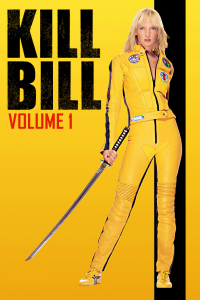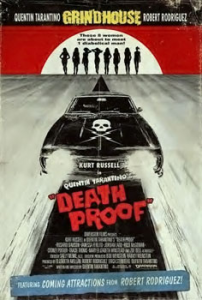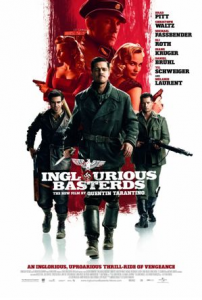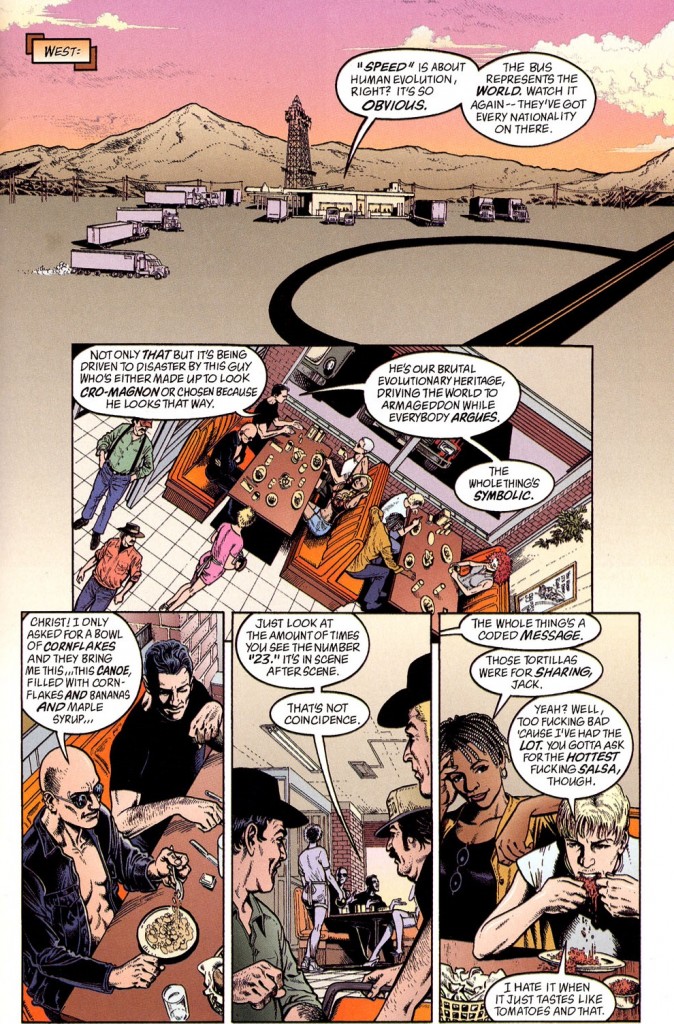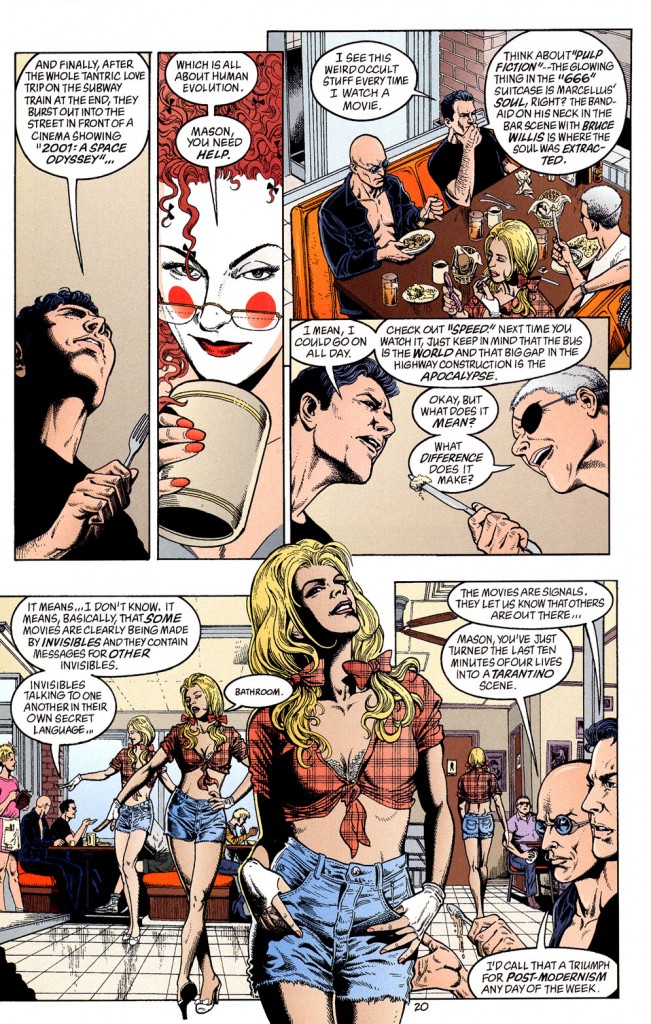If you read the last post, you know what’s going on. Here are more comic suggestions for fans of Quentin Tarantino’s films:
After the subdued crime drama Jackie Brown, Tarantino abandoned all pretenses of realism and embarked on a series of stylized projects, starting with the surreal revenge opus Kill Bill. A blast of energy, ultra-violence, and over-the-top aesthetics, this shamelessly schlocky pop culture collage sees Uma Thurman kill and maim her way through an assortment of pulpy archetypes deliciously called the Deadly Viper Assassination Squad. It’s split in two volumes, the first one a dazzlingly choreographed bloodbath drenched in orientalist iconography (complete with a sick animé sequence) and the second one a relatively more introspective neo-western – yet both equally basking in geeky Easter eggs and fetishistic mutilation.
In comics, that’s the recipe behind Hard Boiled, the early ‘90s nutso cyberpunk classic written by Frank Miller and deliriously illustrated by Geof Darrow. The plot revolves around a psychotic tax collector who is actually a confused insurance investigator who is actually a cybernetic killer (or maybe not), but the plot is not the point. The point is the all-around visual orgy of kinetic destruction.
If you prefer something more recent, then start getting Deadly Class. Written with gusto by Rick Remender, this ongoing series about a school of assassins is brought to the page by what is arguably the best fucking art team in comics today – Wesley Craig and Lee Loughridge, whose depictions of martial arts and murder mayhem can be just as inventive and exhilarating as any action scene in Kill Bill…
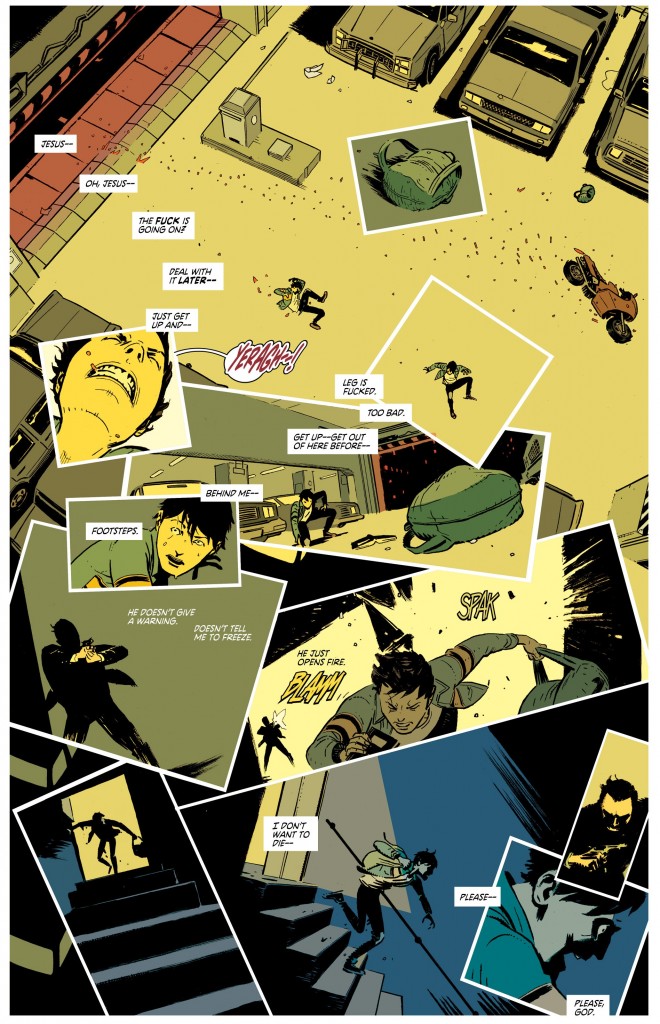
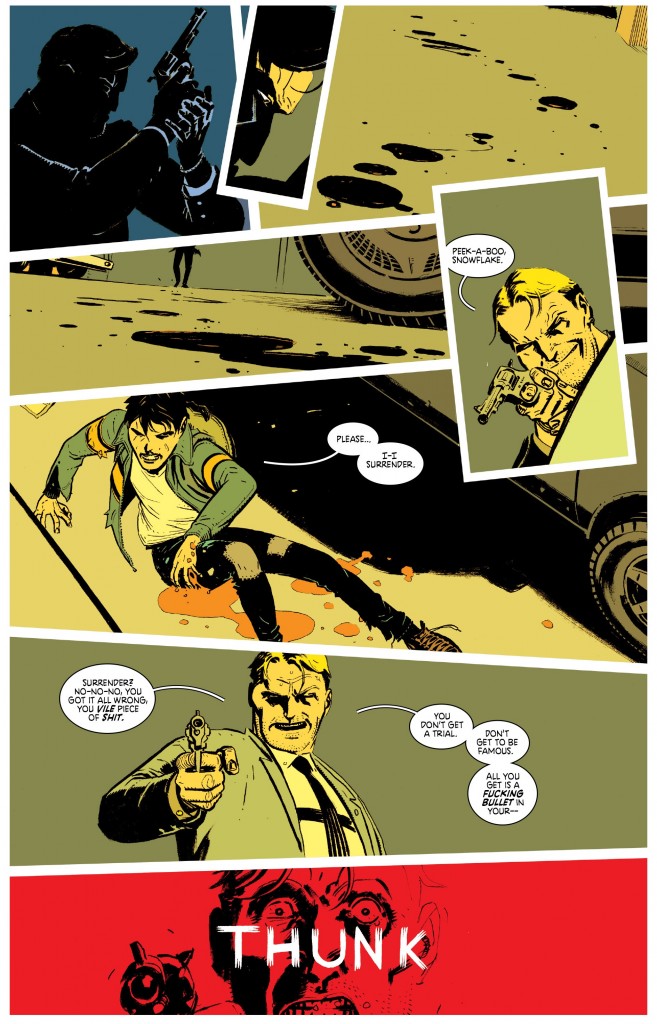
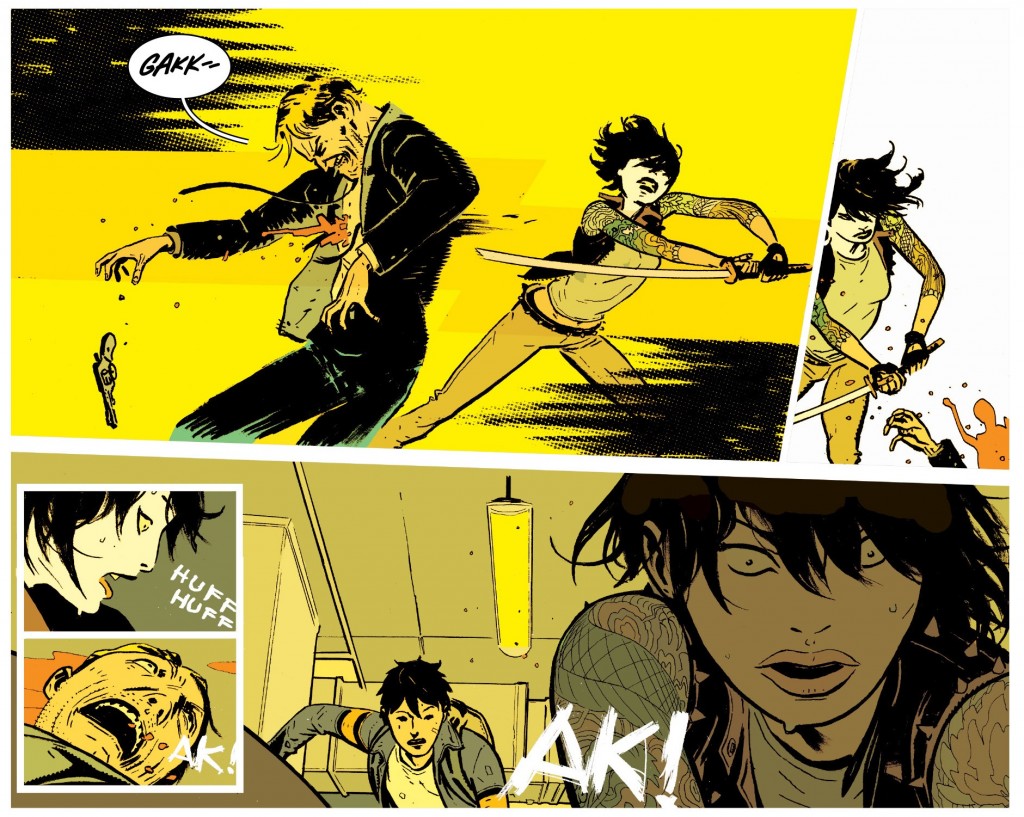 Deadly Class #1
Deadly Class #1
Then there was Death Proof, Quentin Tarantino’s half of Grindhouse, the pastiche of B-movie double bills he did with Robert Rodriguez in 2007. It’s a throwback to the ‘70s, including to the original Mad Max, but if you squint, you can see parallels with the recent Fury Road as well, in that they both tell car-centric stories about empowering women. That said, while George Miller’s latest masterpiece is a flashy spectacle of relentless chases across a futuristic wasteland, Tarantino settled for a deliberately patchy slasher with long stretches of colorful banter and Kurt Russel as a serial killer called Stuntman Mike (who I assume is a descendant from the truck driver in Spielberg’s Duel). Sure, this flick lacks the gravitas of his other directorial efforts, but the thing is that Death Proof – especially the longer version which was distributed separately – still works as a nasty little bare-bones chiller, even if you disregard the fact that it’s a tongue-in-cheek tribute to exploitation films (hey, what Tarantino picture isn’t, to some degree?).
Death Proof definitely comes to mind when reading Bitch Planet, another riff on the cheap thrills of sleazy cinema (in this case blaxploitation, low-budget sci-fi, and above all women-in-prison flicks). Set in a misogynistic dystopia where ‘non-compliant women’ are sent into space, Bitch Planet’s idiosyncratic take on feminism (including some wonderful satirical adverts) is likewise bound to piss off critics across genders. Yet if writer Kelly Sue DeConnick clearly shares Tarantino’s passion for B-movies, she has enough ironic distance towards trashy genre fiction to mock its sexist tropes while giddily rejoicing in its guilty pleasures. The result is a manic and refreshing read, made even cooler by Valentine De Landro’s retro art, particularly on the series’ magnificent covers.
Of course, Death Proof was only part of the overall Grindhouse project. For the first half of this double-feature, Robert Rodriguez provided a cartoonish spin on zombie plagues, Planet Terror, where Tarantino had a small role as a rapist with mutant genitals. While less artsy and pretentious than his partner in crime, Rodriguez doesn’t lack panache – he made the most out of the chosen format, namely through a great gag about missing footage. There were also amusing faux trailers by various directors, including one for Machete, which Rodriguez later turned into its own riotous feature film (followed by the even sillier Machete Kills). My suggestion for fans of this kind of grungy-looking violent action is Rafael Grampá’s off-kilter one-shot Mesmo Delivery, about a truck ride that goes horribly wrong:
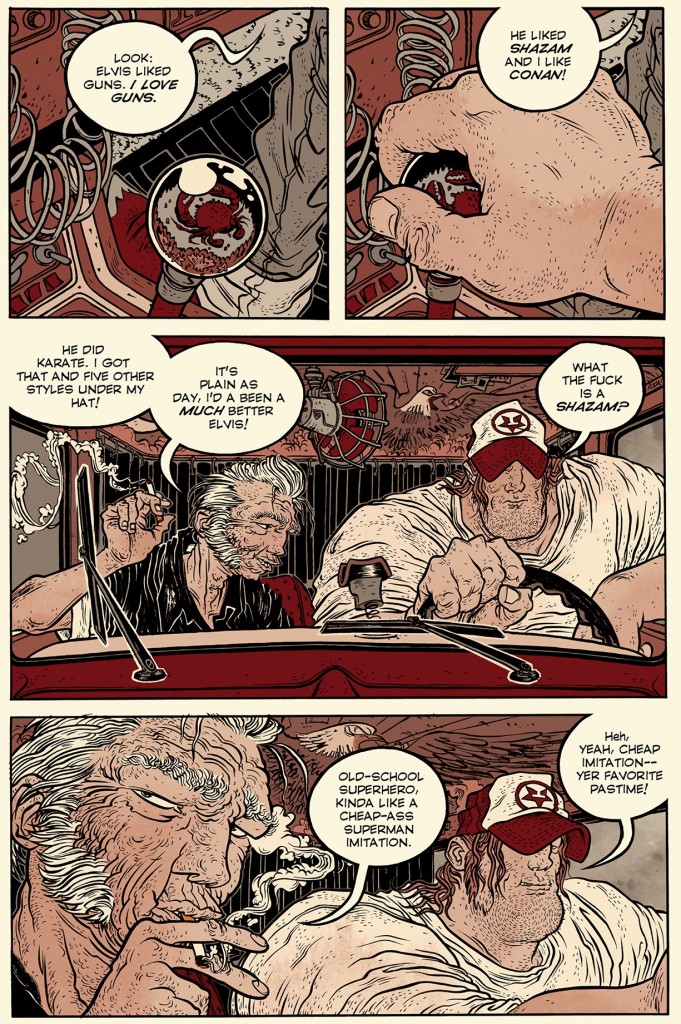 Mesmo Delivery
Mesmo Delivery
And what about Inglourious Basterds, the suspenseful, tightly edited slice of nazixploitation set in Quentin Tarantino’s revisionist version of World War II (in which, naturally, cinema is the most powerful weapon of all)? Tarantino explicitly drew on the string of macaroni combat productions that followed The Dirty Dozen‘s sadistic footsteps, but he ended up with a spy comedy which, I think, owes just as much to the escalating farce of the original To Be or Not to Be, especially the climax at the premiere of a hilariously crude propaganda film in occupied Paris. (As quirky a WWII adventure as Inglourious Basterds certainly is, though, it’s still not as quirky as Hannibal Brooks, the oddball picture about Oliver Reed trying to take an elephant across Europe in 1944.)
It’s hard not to go overboard with this one, since anti-Nazi retribution is such a beloved theme in comics. Even if one is to resist the temptation of once again bringing up Garth Ennis (who has done *tons* of WWII stories), there is still plenty left to choose from… Regarding the artistic side of the war in occupied France, you’d be hard-pressed find a more thoughtful and well-crafted book than Moving Pictures, by Kathryn and Stuart Immonen. But let’s face it, many fans will be less interested in ‘thoughtful’ than in ‘bombastic pulp’ when searching for the comics’ equivalent of Inglourious Basterds. And in the mouthwatering absence of what would have been Jack Kirby’s version of the film, one option could be to settle for The Iron Ghost: Geist Reich, an enjoyable whodunit about a Shadow-ish avenger in bombed Berlin during the last days of the war, courtesy of Chuck Dixon and Sergio Cariello.
Or better yet, go get Seven Psychopaths, by Fabien Vehlmann and Sean Phillips, about an even more outlandish mission to assassinate Hitler…
As for Django Unchained, this incendiary mix of spaghetti western and blaxploitation took the revenge fantasy format of Kill Bill, Death Proof, and Inglourious Basterds to a new extreme by applying it to America’s history of slavery. Like its predecessors, the film went for subversive entertainment in the shape of a rollicking ballet of gory catharses and shocking anti-climaxes, but it struck a deeper nerve in the Obama-era zeitgeist of racial identity politics. To be fair, as gut-wrenching as Django Unchained can be, it’s still lighter than the Sergio Corbucci westerns that inspired Tarantino, if nothing else because of the inclusion of uproarious humor (at some points nearing the similarly-themed satire of Blazing Saddles). This left critics to puzzle over what’s more politically incorrect – the notion that the movie is a tasteless genre exercise or the disturbing implications of taking it seriously? Me, I think the moral confusion is part of the appeal. I can appreciate why many people would prefer a safe, sentimental approach to this topic, or even a more complex and profound one, but I find there is something entrancingly mesmerizing about the way Tarantino keeps stretching out the Monsieur Candie dinner scene into ever-increasing uncomfortable directions.
For a seemingly less transgressive engagement with the issues of Django Unchained, you may want to go with Kyle Baker’s Nat Turner, about the titular real-life African-American slave who led a rebellion in 1831. This powerful graphic novel is more respectfully straight-faced, although Baker doesn’t shy away from vivid sensationalism. He also takes the chance to indulge in virtuoso storytelling – most of the book is ‘silent,’ with Baker’s expressive art carrying the bulk of the narrative.
Django Unchained actually got a sequel of sorts in comics: a crossover mini-series with Zorro written by Quentin Tarantino and Matt Wagner, and illustrated by Esteve Polls. What’s more, the film’s original script has been directly adapted, with art by R.M. Guéra and colors by Giulia Brusco. The latter team was no doubt picked because of their impressive work in Scalped, the critically acclaimed crime series set in an Indian reservation. And honestly, if you want an intense, provocative take on the tropes of the western genre, I don’t think anything can beat Scalped.

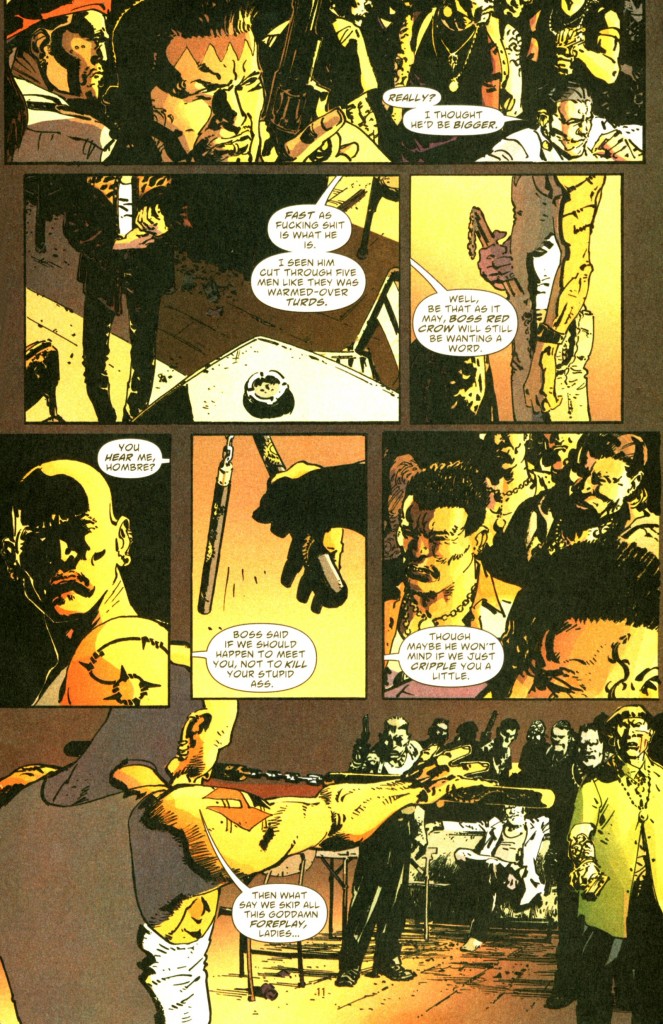
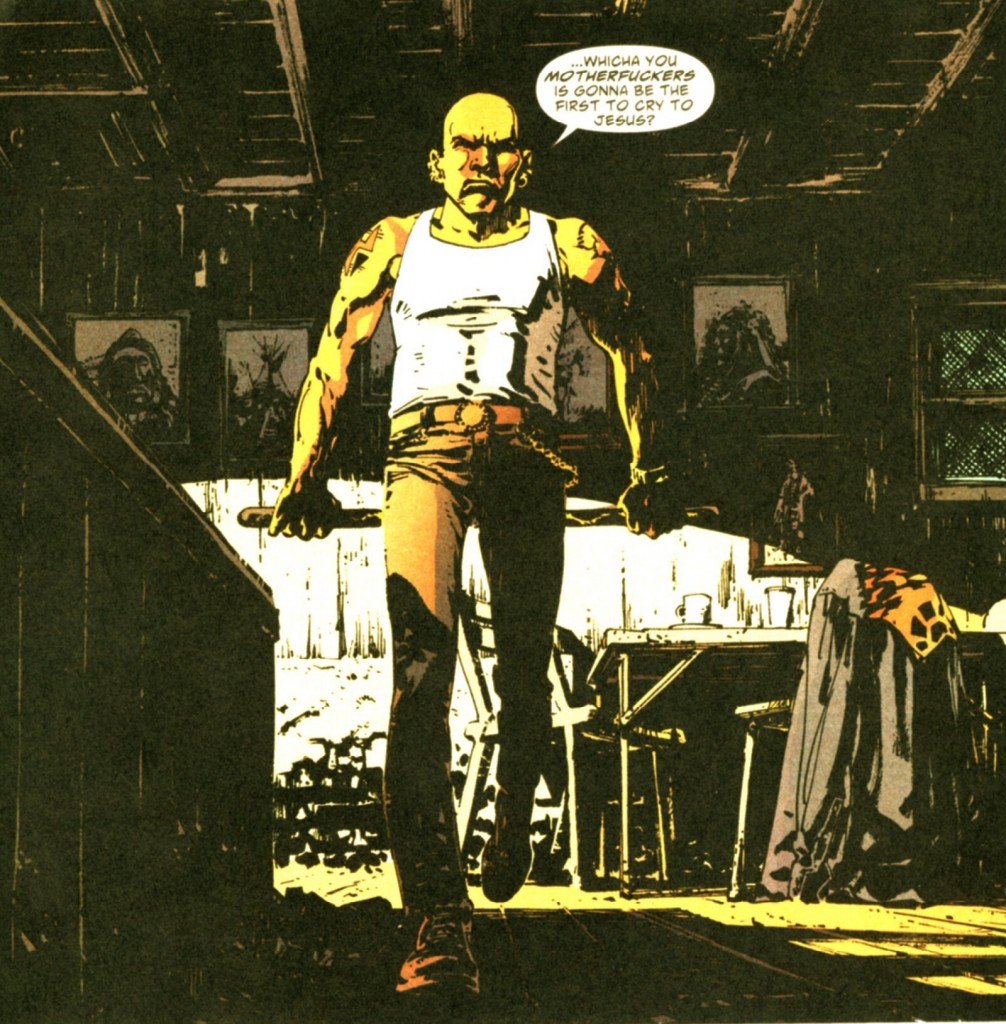 Scalped #1
Scalped #1
Finally, we come to The Hateful Eight, Quentin Tarantino’s latest love letter to cinema… Well, unfortunately I will only be able to watch it next week, so I don’t have any suggestions for this one yet. But I promise to write something about it soon!
In the meantime, I’ll leave you with a neat homage to this iconoclastic director from The Invisibles, Grant Morrison’s metaphysical conspiracy thriller about an international secret society trying to liberate human consciousness. The Invisibles’ financier, billionaire Mason Lang, mentions Pulp Fiction during a monologue about movies in a scene at a diner which – as team leader King Mob points out – feels like it’s straight out of a Tarantino film:

